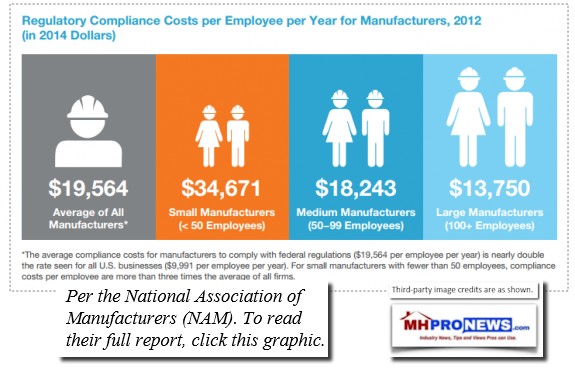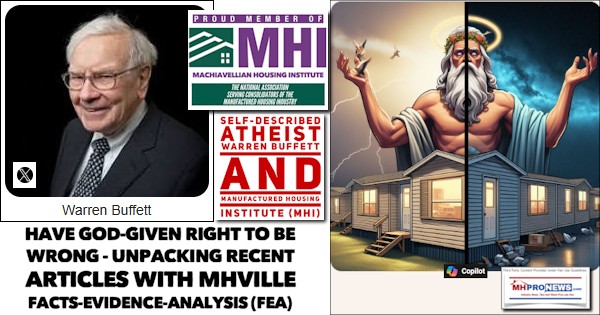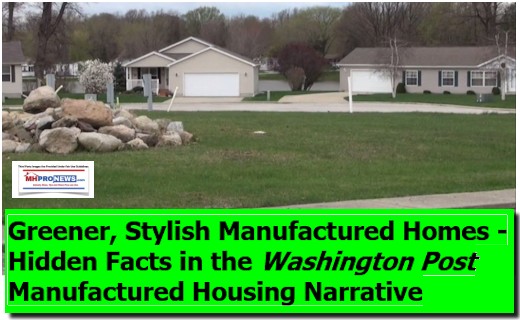
Whatever one thinks about their political leanings, the Washington Post is one of the most important and influential news publications in America.
They decided to publish an article recently about the HUD Code manufactured housing program.
More specifically, the Washington Post (WaPo or WP) wrote about the inner workings of HUD under the Trump Administration, with Secretary Ben Carson at the helm.
The WP’s award-winning Juliet Eilperin wrote about the quality of today’s manufactured homes, specifically citing Secretary Carson’s quote about how “amazing” they are.
Eilperin’s article also talked about both national manufactured housing associations.
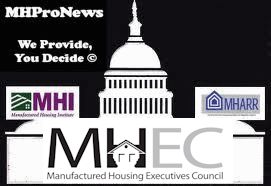
As long-time Daily Business News readers know, there are two national associations that work in manufactured housing. There is the larger of the two, the Manufactured Housing Institute (MHI), based in Arlington, VA. That’s right across the river from Washington, D.C.
Then there’s the Washington-based Manufactured Housing Association for Regulatory Reform (MHARR).
Decades before, the Washington Post published another article about the association known today as MHARR. That article focused on MHARR’s fight with HUD for a removable chassis for manufactured homes. We will return to that removable chassis point later.
It isn’t at all odd that there are more than one national association for manufactured housing.
In conventional housing, there are:
- The National Association of Home Builders (NAHB), a “producers” association.
- There is the National Association of Realtors (NAR), a “Post-production” trade group focused upon the resale of existing homes.
- There is the Mortgage Bankers Association (MBA), and they focus more on financing of new construction, the resale of existing homes, and the refinancing of homes.
The list of housing associations goes on to multiple-family housing, remodeling, and more.
So, if anything, manufactured housing presently has fewer associations than conventional housing does.
That helps explain one reason why, perhaps, that a HUD official told MHProNews that they ‘don’t expect the manufactured housing industry to speak with one voice.’ Unity doesn’t exist in housing. Nor is there full unity in the automotive trade association world either, where dealers and producers have separate associations.
Those separate trade bodies often sit down, or via conference calls, communicate and work with each other to resolve issues and differences on legislative or other matters.
So manufactured housing isn’t unique, and Eilperin’s Washington Post article helped highlight that important detail.
So-called unity in manufactured housing is not to be expected any more than in other professions.
More Hidden-in-Plain-Sight WaPo Insights
But there is more to her Washington Post article, for those who read it carefully and objectively.
In America today, it’s become commonplace to understand that media has an agenda.
What the 45th president calls “fake news,” is at times agenda driven, weaponized reporting. There are partisans on both sides of the left-right divide that sharpen their articles to reflect their perspectives. It’s more out-in-the-open today, and thanks to research like award-winning Sharyl Attkinsson’s, we now have a chart – the one below – to reference that helps readers understand the left-right bias of a given major news source.
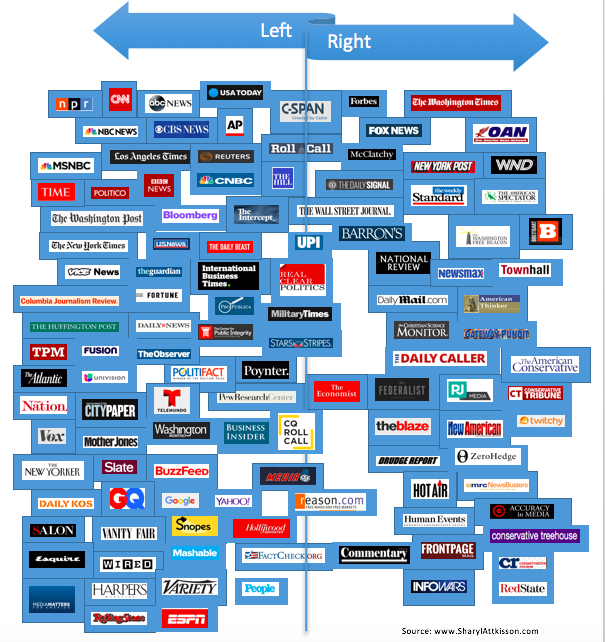
From the far left – The Nation – to the right – Breitbart – there are voices in media that have focused on the problematic issue of monopolistic dominance of certain sectors of the American economy.
Progressive “Nation” Reports on Monopolies Cites Buffett, Clayton, Others – MH Industry Impact?
In manufactured housing, The Atlantic, The Nation, the Seattle Times, the Washington Post, the New York Times, and Fox News are among those mainstream media outlets that have focused reports on various aspects of manufactured housing.
Bloomberg, HousingWire, Realtor and Fox all suggest Manufactured Homes as Important Solution for Affordable Housing in America – manufacturedhomelivingnews.com
While housing becomes more and more expensive across the United States, there’s a simple solution. For those who either want to be frugal and still get great quality or those who have limited funds, but desire to be a homeowner – the answer, suggests and HousingWire – could be modern manufactured homes.
Let’s note that while agendas exist, affordable housing isn’t a partisan political issue.

That’s what former MHARR president, Danny Ghorbani has said, that the manufactured housing industry can work successfully with both sides of the political aisle. He’s right, and that’s been the industry’s history for decades.
The contrast between MHARR and MHI is an interesting and notable one. And Eilperin’s WaPo narrative helped highlight it.
MHI has a political action committee, or PAC. MHARR does not.
MHI says they represent ‘all aspects of factory-built housing,’ meaning production and post-production, including lending, suppliers, etc. It also means MHI represents manufactured homes, and modular too.
MHARR, by contrast, clearly states they represent only the interests of the independent producers of HUD Code manufactured housing.
That said, MHARR has an interest in seeing independent retailers, builder/developers and communities thrive. After all, that’s their client base.
MHI has several times MHARR’s annual budget, and far more staff.
Yet the Washington Post report on the controversy at the Office of Manufactured Housing Programs (OMHP) made clear that it was MHARR that succeeded at having Pam Danner removed from her role as administrator over the HUD Code manufactured home program.
Meanwhile, it was MHI that contributed to or influenced having Lois Starkey removed from her roll at HUD.
Why?
And why were the documents related to MHI’s effort to remove Starkey – note that those memos were dated months before the Washington Post story – why did take their attorney so long to complain to HUD after Starkey left MHI?
MHProNews published the fact that Starkey was at HUD, and MHI knew it before from other sources at HUD too. So, why did MHI delay their protest of Starkey joining HUD?
HUD’s Pam Danner Announces former MHI VP Lois Starkey Joining HUD
Eilperin’s Washington Post report is a rich, revealing narrative. For example, it reflects an anti-Trump Administration stance. Eilperin says that the Trump Administration is trying to take control of all aspects of the federal government, even this previously obscure office manufactured housing office buried deeply away at HUD.
News flash. Every president tries to take control over the federal government. It’s part of the job description for the chief executive of the United States of America.
But Eilperin raises an important point: with an affordable housing crisis raging in America, why has manufactured housing been tucked away in obscurity for so long at HUD?

What MHI EVP Lesli Gooch admits to doing, is surprising too.
Per Gooch to WaPo, MHI wanted to see HUD restructure the manufactured housing program office within the broader arrangement at HUD. Hmmm…okay, duly noted.
But what Pam Danner did was a clear federal overreach of her office’s power, from the perspective of hundreds of manufactured housing operations across the country. Why wasn’t MHI’s response to Danner’s overreach to try – as did MHARR – to have Danner removed?
Note that even though MHI and state associations – which are arguably dominated by MHI, as MHProNews has previously reported – also had members that wanted Danner’s removal.
So why didn’t MHI listen to their own grass roots?
Thus, MHARR is made to be – from an industry reading of the WaPo narrative – an association hero.
MHI’s own EVP frankly stated they were doing something different than seeking Danner’s removal. In fact, the action taken by MHI’s attorney toward Starkey was surprising. MHI’s outside counsel literally said in part that MHI considers HUD to be MHI’s client.
HUD a client of MHI?
Surprising, but it is there in black and white. Was that ‘client’ reference a boiler-plate-letter oversight that was sent by MHI’s outside counsel to HUD uncorrected? Or does MHI literally believe HUD is MHI’s client?? Isn’t either an embarrassment?
Go to the WaPo article – linked here – and see the downloadable related documents Eilperin obtained for yourself.
The WaPo narrative is rich in such details and insights. Eilperin did the industry numerous favors in how her article is framed, which is seemingly meant as a hit at Secretary Carson, and the Trump Administration. But a careful reading of her narrative with insights like those noted herein reveals instead that Team Trump are reforming years of prior HUD Code program regulatory overreach that Dr. Carson called “ridiculous.”
Our sources tell us that the new status quo at the HUD manufactured housing program office is expected to continue under the temporary leadership of Teresa Payne. Payne led the program once before, as long-time MHProNews readers with a keen mind recall.
The Daily Business News is also told to expect a slow-dance on the Brian Montgomery appointment by the Senate. Until that time, Dana Wade is ably serving Secretary Carson in a key spot, and seems to be doing so in a manner that keeps both trade groups – for now – officially pleased.
Another Bottom Line?
The WaPo narrative reveals many more details. Each of them confirms numerous, prior MHProNews reports and commentaries. It’s an opportunity, as a reader prodded us, to say “I told you so” about MHI being the de facto road-block to not having Danner removed even sooner. See Transparency, among many other reports that were confirmed by WaPo, linked below for later in-depth reading.
The Masthead
First, the readers digest version, then the details. Last week, the WVHI sent out their newsletter with a column apparently written by their co-president, George Gunnell. Gunnell is an RVP for Clayton Homes. That article and others in the same newsletter indicated that MHI wanted Pam Danner ousted from her role at HUD.
Another thought provoking point for this weekend is this. MHI allowed HUD to overreach, without asking for Pam Danner’s removal. Why?
Who, besides big businesses, benefit when all sizes of businesses are being oppressed?
MHProNews has taken pains for years to lay out the cases that point to the fact that heavy regulation harms smaller businesses more than bigger ones.
In banking, community banks suffered under Dodd-Frank, even though community banks arguably had far less impact on the financial meltdown that gave rise to the birth of Dodd-Frank and the CFPB in the first place. Even giant U.S. Bank closed its manufactured housing program, not because it wasn’t profitable. Rather, U.S. Bank pulled the plug due to regulatory risks and not enough volume to make up for those risks. For later in-depth reading, click the below.
The Masthead
We’ve heard for some time the whispers about the now announced closure of U.S. Bank’s indirect manufactured housing lending program. To protect sources, we’ve been unable to do more than hint before today about what is now a done deal. We didn’t have a date, but knew it was ‘coming.’
-
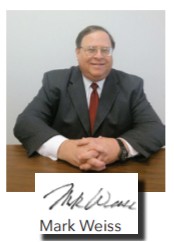
Mark Weiss, President and CEO of the Manufactured Housing Association for Regulatory Reform (MHARR). Mark Weiss, JD, at MHARR is portrayed by WaPo’s journalist as working to relieve the burdens imposed by Danner at HUD.
- MHI is shown as allowing those burdens to stand.
- Read that in the context of Smoking Gun 3 under related reports at the end, and you may never see manufactured housing industry politics the same ever again.
What About that Removal Chassis?
As to a removable chassis?
If manufactured housing were allowed by HUD to have removable chassis, as MHARR decades ago tried to accomplish, manufactured homes – with a chassis removed – would be:

- lower to the ground once installed.
- They would look even more like a conventional house, once installed.
- It would cost less to put a foundation enclosure around a manufactured home without a chassis that it normally does with one now.
- Sans the chassis, it would remove the impression of the home being mobile, when most manufactuerd homes aren’t moved once installed.
- It would be greener to recycle the chassis.
- It might even save money.
MHARR fought for that removable chassis, decades ago. Isn’t all of that stylish, green, and visionary? ## (News, analysis and commentary.)
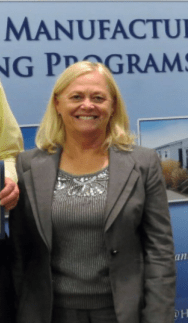
1) Post-Script: Our sources at and connected to HUD tell us that the Eilperin’s report was prompted by a desire of “allies” of Pam Danner to undermine Dr. Carson and his team’s leadership as Secretary at HUD.
2) The WaPo report is written in a way that makes Danner’s work as administrator look consumer focused, but what’s missing is the fact that service-related issues with HUD Code manufactured homes are so few, that out of the roughly 92,900 homes built last year, only a few dozen nationally went to dispute resolution. There is no similar dispute resolution program for site-built housing to settle consumer concerns. So those service issues highlighted in Eilperin’s narrative are a rarity, a point her narrative didn’t cover. That’s not a tag on her work, no one story can cover every detail.
3) There are HUD connected sources that tell MHProNews that WaPo’s article signals an upcoming battle for HUD Code homes, at the state installation level.
4) There are industry voices that say that the time to prepare for that installation – a post-production battle – is now. Discussions about enhanced preemption are, per reports, being carefully reviewed at HUD. There are concerned sources in MHVille that say the need for an effective post-production association has never been greater.
5) The WaPo narrative makes it clear that MHI isn’t that effective at stopping HUD’s over-regulation. In the association national realm, it was MHARR’s handiwork – not MHI’s – that proved effective for retailers, communities, and for the consumers they serve. Of course, MHProNews covered it all in a “follow the evidence, follow the facts, follow the money” way that no other industry media even attempted to do. “We Provide, You Decide.” ©
(Third party-images and content are provided under fair use guidelines.)
Related Reports:
It’s been hailed as the most important report on this topic to date…
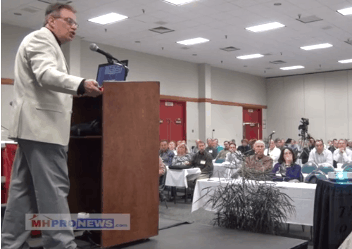
By L.A. “Tony” Kovach – for MHProNews.com.
Tony is the multiple award-winning managing member of LifeStyle Factory Homes, LLC, the parent company to MHProNews, and MHLivingNews.com.
Office 863-213-4090 |Connect on LinkedIn:
http://www.linkedin.com/in/latonykovach
Click here to sign up in 5 seconds for the manufactured home industry’s leading – and still growing – emailed headline news updates.

